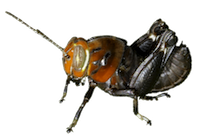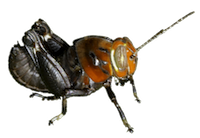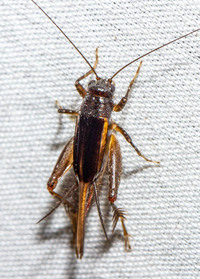Family (Alpha): ACRIDIDAE GRYLLACRIDIDAE GRYLLIDAE GRYLLOTALPIDAE RHAPHIDOPHORIDAE ROMALEIDAE TETRIGIDAE TETTIGONIIDAE TRIDACTYLIDAE
View Gryllidae Members:
Acheta domesticus Anurogryllus arboreus Gryllus unidentified species Gryllus firmus Gryllus fultoni Gryllus pennsylvanicus Gryllus pennsylvanicus/veletis Gryllus pennsylvanicus-veletis Gryllus rubens Gryllus veletis Miogryllus verticalis Velarifictorus micado Hapithus agitator Orocharis unidentified species Orocharis luteolira Orocharis saltator Cycloptilum unidentified species Cycloptilum bidens Cycloptilum pigrum Cycloptilum slossoni Cycloptilum tardum Cycloptilum trigonipalpum Cycloptilum velox Myrmecophilus pergandei Allonemobius allardi Allonemobius fultoni Allonemobius griseus griseus Allonemobius griseus funeralis Allonemobius maculatus Allonemobius socius Allonemobius sparsalsus Allonemobius tinnulus Allonemobius walkeri Allonemobius unidentified species Eunemobius carolinus Eunemobius confusus Eunemobius melodius Eunemobius unidentified species Neonemobius cubensis Neonemobius palustris Neonemobius variegatus Pictonemobius ambitiosus complex Pictonemobius ambitiosus Pictonemobius hubbelli Nemobiinae unidentified species Oecanthus unidentified species Oecanthus celerinictus Oecanthus exclamationis Oecanthus fultoni Oecanthus latipennis Oecanthus nigricornis Oecanthus niveus Oecanthus pini Oecanthus quadripunctatus Neoxabea bipunctata Phyllopalpus pulchellus Anaxipha delicatula Anaxipha exigua Anaxipha litarena Anaxipha rosamacula Anaxipha thomasi Anaxipha tinnula Anaxipha tinnulacita Anaxipha tinnulenta Anaxipha vernalis Anaxipha new species near vernalis Anaxipha unidentified species Cyrtoxipha columbiana Falcicula hebardi Gryllidae unidentified species NC Records
Neonemobius cubensis (Saussure, 1874) - Cuban Ground Cricket
Taxonomy
Family: Gryllidae
Subfamily: NemobiinaeTribe: PteronemobiiniComments: One of six species in this genus that occur in North America north of Mexico (Cigliano et al., 2017), three of which have been recorded in North CarolinaSpecies Status: The type specimen of cubensis is from Cuba but this is a widespread species, occurring in eastern North America, the Caribbean, and eastern Meso-America (Cigliano et al., 2017). According to Johnstone and Vickery (1970), there may be an undescribed species, N. new species nr. mormonius in the Cubensis complex. It is distinguished by the slightly higher pulse rate of the male calling song and its preference for drier habitats than occupied by either cubensis or palustris . It reportedly occurs in Georgia, northern Florida, and westward along the Gulf Coast. The map shown on SINA for Neonemobius mormonius appears to incorporate these Southeastern records, treating all of these records as belonging to that species.
Identification
Field Guide Descriptions: Himmelman (2009) Online Photographs: SINA, BugGuide , Songs of Insects, Google Images ,
iNaturalist , GBIF Technical Description, Adults/Nymphs: Hebard (1913); Johnstone and Vickery (1970)SINA 537a.htm Comments: Cubensis is a small, brownish-black ground cricket that is similar in general appearance and color to palustris but is not as solid in coloration, possessing patches of pale grayish-buff markings (Hebard, 1813; Johnstone and Vickery, 1970). The tegmina typically have a pale line that separates the dorsal and lateral fields. Total Length [body plus wings; excludes ovipositor]: 5.7-6.6 mm, brachypterous males (Florida specimens); 5.6-7.0 mm, brachypterous females (Hebard, 1913)Structural Features: Members of Neonemobius are distinguished by their small size -- males are less than 9 mm in body length. Females also possess short, upwardly curved ovipositors, less than or equal to 2/3 the length of the hind femur, and that have fine teeth only on the dorsal side of the tip (SINA, 2017). Both macropterous and brachypterous forms have been recorded in this species (Hebard, 1913)Singing Behavior: Fulton (1931) describes the song of cubensis as a very high pitched, thin whistle. Each trill lasts from 8 to 15 seconds, occasionally up to 30, with similar length pauses between trills. Each trill starts soft and builds in amplitude, ending abruptly. According to SINA, the pulse rate ranges from 38 pulses per second at around 65 F up to 60 at temperatures above 80 F. The pitch of songs recorded in the Macaulay Library range from 6.9 to over 9.5 kHz. In the graph presented below that plots pulse rate vs. pitch, a linear relationship does not appear to exist, with several records having pulse rates of 59 to 60 syllables per second but covering a very wide range of pitches. All of these records were recorded during the day and come from fairly wet habitats, which is consistent with those reported for cubensis but different from the drier habitats used by mormonius .Diagnostic Song Parameters: Recording playback at normal speed.
Download Video:
"MP4"
Distribution in North Carolina
County Map: Clicking on a county returns the records for the species in that county.
Adult Dates: Click on graph to enlarge
Habitats and Life History
Habitats: Fulton (1931) states that cubensis is largely a marsh species, found at the edges of both freshwater and brackish marshes; also found along streams and other moist places with dense herbaceous cover. Diet: Probably omnivorousObservation Methods: Most easily detected by its song. Long-winged individuals are also seen at moth sheets with 15 watt UV lights.Abundance/Frequency: Adult Phenology: In the vicinity of Raleigh, Fulton (1951) observed adults appearing by July 1 and persisting until the end of October
Status in North Carolina
Natural Heritage Program Status: Natural Heritage Program Ranks: GNR SNR [S4S5]State Protection: Has no legal protection, although permits are required to collect it on state parks and other public landsComments: This species appears to be widespread and occupies fairly common habitat types. It therefore seems to be secure within the state.
Image Gallery for Neonemobius cubensis - Cuban Ground Cricket Recorded by: Mark Basinger and Jim Petranka Recorded by: Mark Basinger Recorded by: Mark Basinger Recorded by: Mark Basinger Recorded by: Mark Basinger Recorded by: Mark Basinger Recorded by: David George Recorded by: Michael P. Morales Recorded by: Michael P. Morales Recorded by: Steve Hall and Bo Sullivan Recorded by: Steve Hall and Savannah Hall Recorded by: Steve Hall and Bo Sullivan Recorded by: Steve Hall and Bo Sullivan Recorded by: Steve Hall and Bo Sullivan Recorded by: Steve Hall and Dee Stuckey Recorded by: Steve Hall, Bo Sullivan, and Arno Schadt Recorded by: Steve Hall

 »
»

 »
»